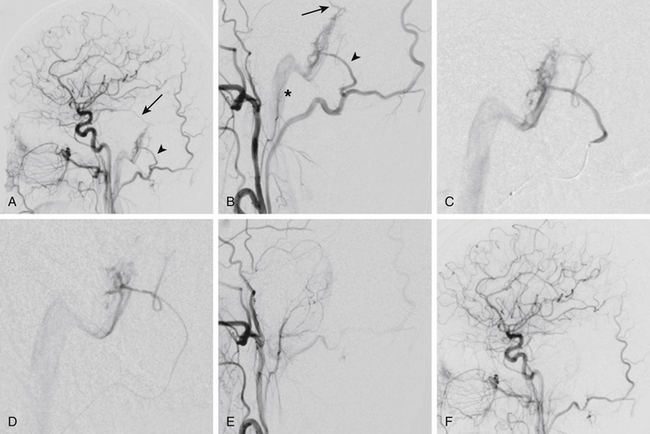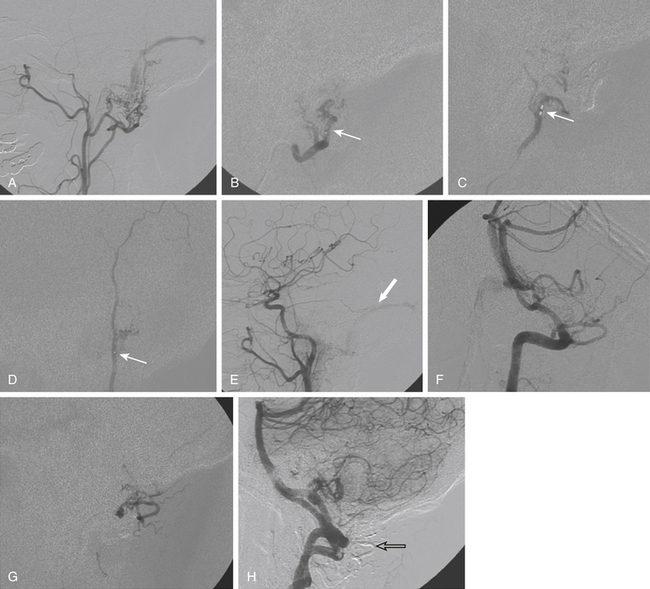Chapter 90 Endovascular Management of Dural Arteriovenous Fistulas
Dural arteriovenous fistulas (DAVFs), also sometimes referred to as dural arteriovenous malformations, represent approximately 10% to 15% of all intracranial arteriovenous malformations. These lesions can occur in the brain and the spine and are characterized by abnormal arteriovenous shunts located within dural leaflets. Cranial DAVFs are most commonly located in the vicinity of dural venous sinuses and spinal DAVFs in the region where the radiculomedullary artery enters the dural root sleeve. The etiology of DAVFs is unknown, but many are acquired and can occur after trauma (e.g., skull fracture), surgery, sinus thrombosis, and venous channel stenosis.1–4
The pathophysiology and clinical significance of DAVFs stem from the location of the fistula or shunt and its effect on and disruption of normal venous drainage. Various classification systems have been published in the literature, with the key feature in each being the pattern of venous flow.5–8 Borden et al. organized DAVFs into three groups: Type I DAVFs drain directly into meningeal veins or dural venous sinuses. Type II DAVFs also drain directly into dural sinuses or meningeal veins but have retrograde drainage into subarachnoid veins. Type III DAVFs do not have dural sinus or meningeal venous drainage; rather, they drain directly into subarachnoid veins.8 Cognard et al. proposed a classification scheme with five main types: Type I DAVFs drain directly into dural venous sinuses or meningeal veins, and all venous flow is anterograde (in the normal direction). Type II DAVFs drain into dural sinuses or meningeal veins but have retrograde flow into the associated sinus (type IIa), cortical veins (type IIb), or both (type IIa+b). Type III and IV DAVFs drain directly into cortical veins either with (type III) or without (type IV) venous ectasia. Type V DAVFs include spinal venous drainage. DAVFs without cortical venous reflux (CVR) (Cognard types I or IIa or Borden type I) are generally considered benign.7 Satomi et al. demonstrated that conservative management or palliative therapy is sufficient in 98% of cases of benign DAVFs; however, these patients have a 2% risk of developing CVR.9 DAVFs with persistent CVR (Cognard types IIb-V or Borden types II and III) are much more aggressive, with an annual mortality of 10.4% and annual risk of hemorrhage or nonhemorrhagic neurologic deficit of 8.1% and 6.9%, respectively.10 Symptomatic DAVFs are associated with variable clinical presentations, depending on the location of the shunt and the severity of venous hypertension secondary to retrograde leptomeningeal venous flow. Approximately 20% to 33% of symptomatic DAVFs present with intracranial hemorrhage.4,10 Other presentations include pulsatile tinnitus (or bruit), headaches, visual changes, alterations in mental status, seizure, myelopathy, cranial nerve palsies, and motor or sensory deficits.
DAVFs can be treated by surgical techniques, endovascular techniques, a combination of surgical and endovascular techniques, or radiation therapy. For endovascular management, embolization targets are selected based on a thorough understanding of the fistula anatomy. The key is to obliterate the fistulous connections while limiting adverse outcomes, such as inadvertent worsening of cortical venous flow, closing external to internal carotid artery anastomoses, and embolizing external carotid artery branches with important arterial supply to cranial nerves. Transarterial and transvenous approaches are available for endovascular treatment of DAVFs. Embolic materials used in such procedures include n-butyl-2-cyanoacrylate (n-BCA) glue (Trufill, Cordis Neurovascular, Miami Lakes, FL), Onyx (ev3 Endovascular, Irvine, CA), detachable microcoils, and particles of polyvinyl alcohol. Particles are rarely used as a sole agent for DAVF embolization because of their temporary effects. Instead, they are used in certain circumstances as an adjuvant to reduce flow in collateral vessels and promote thrombosis.11
Transarterial Embolization
Transarterial embolization is ideally used for high-grade DAVFs, such as those with direct cortical venous drainage, or in situations in which venous access is limited. Nelson et al. listed the following advantages of transarterial procedures for DAVFs: (1) the arteriovenous fistula transition can be occluded through a transarterial approach, decreasing the possibility of flow diversion into an alternate venous pathway; (2) treatment is not limited by venous access (e.g., stenotic or thrombosed venous sinuses); (3) fistula treatment does not require sacrificing a functional venous pathway; (4) de novo DAVFs can develop at a secondary site following transvenous embolization, possibly as a result of venous hypertension; and (5) complications specific to transvenous routes can be avoided (e.g., abducens nerve palsy from catheterization of the superior petrosal sinus).12
Cyanoacrylic Glue Techniques
Cyanoacrylate adhesives have been used extensively for the embolization of high-flow cerebrovascular lesions,13–15 including DAVFs.11,12,16 n-BCA, a cyanoacrylate ester, is a clear, colorless liquid with a strong odor that is insoluble in water. This agent polymerizes rapidly when in contact with ionic substances, including blood or tissue fluids. Rapid polymerization and excellent tensile strength make n-BCA a highly effective embolic agent for endovascular procedures. However, it must be handled with great care to avoid the high risk of unintentional embolization of normal tissue. n-BCA is diluted with Ethiodol (ethiodized oil) to make the mixture radiopaque. Tantalum or tungsten powder can also be added to increase radiographic visibility.17 The concentration of n-BCA in the mixture determines the migration, or penetration, of the embolic agent prior to polymerization. A high n-BCA–to–Ethiodol ratio (high concentration of glue) polymerizes more proximally in the arterial pedicle than a low n-BCA–to–Ethiodol ratio, which achieves more distal penetration. Glue concentrations of 25% to 33% are commonly used.
For transarterial glue embolization of DAVFs, the microcatheter should be positioned as close to the target fistula site as possible, because this increases the specificity of the injection and facilitates penetration of the embolic material to the fistula site. Wedging the microcatheter within a feeding artery creates a flow-arrest scenario that is thought to facilitate delivery of glue to the fistula site and its permeation into the extensive fistulous collateral network. In a series of 21 patients with 23 DAVFs, Nelson et al. demonstrated complete occlusion in all cases without complications using the wedge catheter technique.12 Wedge catheterization also allows for arterioarterial reflex with occlusion of multiple arterial feeders from a single pedicle injection.11
Once the optimal catheter position is obtained, microcatheter angiography and test injections are used to determine fistula flow characteristics and the appropriate glue concentration for the procedure. Prior to the actual glue injection, the microcatheter must be flushed thoroughly with a nonionic solution, such as 5% dextrose, to ensure that the glue does not polymerize within the delivery catheter. The glue is then injected under direct digital subtraction angiography (DSA) guidance either as a continuous column or as a bolus followed by a column of nonionic flush.17 If there is a suboptimal catheter position (e.g., the catheter is too proximal along the pedicle or the neurointerventionalist is unable to wedge the catheter tip), simultaneous injection of 5% dextrose through the guide catheter can improve distal migration of the glue toward its target.16 After adequate glue penetration, the microcatheter or the whole delivery system (microcatheter plus guide catheter) is rapidly removed from the patient. Communication among operators during a glue procedure is critical so that the catheter is pulled at the correct instant and not glued to the vessel. Examples of transarterial glue embolization of DAVFs are shown in Figs. 90-1 and 90-2.
Onyx Techniques
First reports describing the use of Onyx in vascular malformations were published in 1990.18,19 Onyx has been commercially available in Europe since 1999 and was approved by the U.S. Food and Drug Administration in July 2005.
Onyx is a liquid agent composed of a mixture of ethylene–vinyl alcohol copolymer suspended in the solvent dimethyl sulfoxide (DMSO). Tantalum powder is added to the compound for radiopacity. To obtain homogeneous radiopacity of the mixture, Onyx must be shaken for at least 20 minutes before use. The potential angiotoxic effects of DMSO are negligible if the recommended dose and infusion rate are followed.20–22 The polymer precipitates upon contact with aqueous solution, resulting in a soft, nonadherent material characterized by a “lavalike” flow pattern that is able to produce permanent vessel obliteration. Because of the presence of the solvent, all materials must be DMSO compatible, including syringes and microcatheters.
The therapeutic approach to cerebral DAVF mainly depends on the vascular drainage and CVR pattern of the malformation. In Cognard type II dural fistulas, with or without CVR, the best option, when feasible, remains the transvenous approach with coils or Onyx. However, this option entails the sacrifice of the sinus.23–27 In the same setting, transarterial embolization could have the advantage of preserving the sinus when still functional.
In cases of DAVF with direct CVR Cognard type III to V, the transarterial embolization is the most advantageous technique. Several reports in the recent literature highlight the benefit of Onyx in these cases.24,28–30 Compared to n-BCA glue injection, the Onyx technique has some technical advantages: it is less operator dependent, does not need a wedged microcatheter positioning, and has the capacity to occlude different feeders from a single pedicle with a single injection (Figs. 90-3 and 90-4). This last advantage is particularly relevant when the venous access is limited.28–31 Onyx may also be used in the treatment of cavernous DAVFs. However, in these cases, the transvenous approach is recommended to avoid the risk of cranial nerve damage and penetration into extra- or intracranial anastomoses.23,27
We prefer to perform the embolization procedure under general anesthesia and full heparinization monitored with activating clotting time.30 After a detailed diagnostic angiographic study, possibly including superselective injections of the vessels involved in the dural malformation, an accurate treatment strategy should be planned to select the cases that can benefit from intra-arterial Onyx injection. The strategy should be aimed at (1) locating the point, or points, of fistula; (2) recognizing the feeding arteries; (3) understanding the venous drainage pattern; and (4) selecting the most promising pedicles to be injected based on navigability, expected efficacy, and safety. Biplanar angiography is mandatory. Tridimensional DSA reconstructions and pseudo-CT scans may be useful adjuncts.











